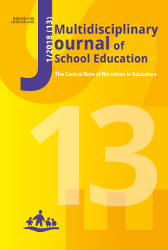Failed Attempt: the Foreign Country of Adolescence in The Go-Between by L.P. Hartley
Abstract
Numbered in the compulsory reading lists, L.P. Hartley’s famous The Go-Between (1953) seems a novel predestined to become a subject of a discussion on relational teaching. The wide acclaim of both the novel and the film may be a proof of its timeless topicality. The present article offers an analysis of the literary rendering of the process of maturation and the meaning of interpersonal relations in adolescence. Next to school environment, private sphere and peer group are scrutinized in terms of the exposure of failed communication processes.
References
Abbey, N. (2016). GSE Reading List. Retrieved from: http://www.kes.net/wp-content/uploads/2016/01/GCSEreadinglist.pdf
Barnard, A. (2012). The Genesis of Symbolic Thought. Cambridge: Cambridge University Press.
Elkind, D. (1995). Ties that Stress. The New Family Imbalance. Cambridge: Harvard University Press.
Erikson, E. H.(1963). Childhood and Society. New York: Norton.
Esteban Bara, F. (2014). Without you none of this would have happened: a consideration of university teaching. Teaching in Higher Education, 19, 747–757.
Fowler, J., Keen, S. (1978). Life Maps. Conversations on the Journey of Faith. Waco, TX: Word Books.
Hartley, L.P. (2000). The Go-Between. London: Penguin Books.
Hillis Miller, J. (2013). Reading for Our Time. Adam Bede and Middlemarch Revisited. Edinburgh: University Press.
James, W. (1902). The Varieties of Religious Experience: A Study in Human Nature. New York: Longmans. Retrieved from: https://csrs.nd.edu/assets/59930/williams_1902.pdf.
Kopaliński, W. (2006). Słownik Symboli. Warszawa: Oficyna Wydawniczna Rytm.
Laurence, T. (1997). Morality and Psychological Development. In P. Singer (ed.), A Companion to Ethics. Oxford: Blackwell.
Lerner, R. M., Roeser, R. W., Phelps, E. (Eds.), (2008). Positive Youth Development & Spirituality. From Theory to Research. West Coshohocken: Templeton Foundation Press.
Natov, R. (2017). The Courage To Imagine. The Child Hero in Children‘s Literature. London: Bloomsbury.
Woolf, V. (2000). The Waves. Ware: Wordsworth Classics.
Jetta, M. K., Segalowitz, S. J. (2012), Adolescent Brain Development: Implications for Behavior, Oxford: Academic Press.
Moshman, D. (2005). Adolescent Psychological Development. Rationality, Morality, and Identity. Mahwah, NJ: Lawrence Erlbaum Associates Publishers.
Putnam, F. W. (1997). Dissociation in Children and Adolescents: A Developmental Perspective. New York: The Guilford Press.
Roeser, R. W., Isaac, S. S., Abo-Zena, M., Brittian, A., Peck, S. C. (2008). Self and Identity Processes in Spirituality and Positive Youth Development. In: Lerner, R. M., Roeser, R. W., Phelps, E. (Eds.). Positive Youth Development & Spirituality. From Theory to Research. (pp. 74 – 108). West Coshohocken: Templeton Foundation Press.
Shelton, C. M. (1991). Morality and the Adolescent. A Pastoral Psychology Approach. New York: Crossroad.
Singer, P. (Ed.) (1997). A Companion to Ethics. Oxford: Blackwell.
Smith, A. (2011, June 17). Rereading: the Go-Between by L. P. Hartley. The Guardian. Retrieved from: https://www. theguardian.com/books/2011/jun/17/lp-hartley-go-between-ali-smith
Spitzer, C., Barnow, S., Freyberger, H. J., Grabe, H.J. (2006). Recent Developments in the Theory of Dissociation. World Psychiatry, 5(2), 82–86. Retrieved from: https://www. ncbi.nlm.nih.gov/pmc/articles/PMC1525127/
Squires, M. (1974). The Pastoral Novel. Studies in George Eliot, Thomas Hardy, and D.H. Lawrence. Charlottesville: University Press of Virginia.
Weinbrot, H. D. (1990). Northrop Frye and the Literature of Process Reconsidered. Eighteenth-Century Studies, 24/2, 173–195.
Weingartner, H. J., Putnam, F., George, D. T., Ragan P. (1995). Drug-state Dependent Autobiographical Knowledge. Experimental and Clinical Psychopharmacology, 3, 304–307.
Wright, A. (2001). Foreign Country. The Life of L. P. Hartley. London: Tauris Parker Paperbacks.

This work is licensed under a Creative Commons Attribution-NoDerivatives 4.0 International License.
-
The Author/Authors declares/declare that their publication is original has not been published before and is not currently being considered for publication elsewhere and does not include borrowings from other works which might cause Publisher's responsibility, does not infringe the rights of the third party and that their copyright on this publication is not limited. The Author/Authors will incur all the costs and will pay compensations which might result from the mendacity of the following statement.
-
The Author/Authors declares/declare that issues about publication ethics, have been appropriately considered.
-
The Author/Authors agrees/agree to publish the article free of charge in Multidisciplinary Journal of School Education in English or Spanish. The Editorial Board reserves the right to shorten the texts and change the titles.
-
As part of free publication mentioned in § 1, the Author/Authors agrees/agree to make the full electronic version of their article available in the Internet.
- The Author/Authors agrees/agree to index their article in databases at home and abroad, including abstracts and keywords as well as Authors’ affiliation in English and in other languages. The Author/Authors agrees/agree to pass on the information mentioned above to the owners of these databases.
-
The Author/Authors declares/declare that the article is free of plagiarism.
-
The Author/Authors declares/declare that funding and conflict of interest information has been included in the article.
-
The Author/Authors accepts/accept that the author is aware of the consequences of scientific dishonesty, which, once detected, will be documented and disclosed to the public, and information about it will be communicated to the relevant institutions (universities employing the authors, scientific societies, publishing houses, etc.).
-
The Author/Authors declares/declare to publish the text in the Multidisciplinary Journal of School Education under a Creative Commons Attribution-NoDerivatives 4.0 International License (CC BY-ND 4.0).
- For one Author. Please complete the Author Statement and send it to the editorial office. Please download, complete, scan and attach the file in the system during the submission process.
Download: Author Statement -
For more than one Author. The Authors declare to bear complete responsibility for the scientific reliability of the article submitted. The detailed contribution of all co-authors is defined. Please complete the Authors Statement-Authorship Contributions and send it to the editorial office. Please indicate the specific contributions made by each author (list the authors’ initials, e.g., JKH). Please download, complete, scan and attach the file in the system during the submission process.
Download: Authors Statement - Authorship Contributions





